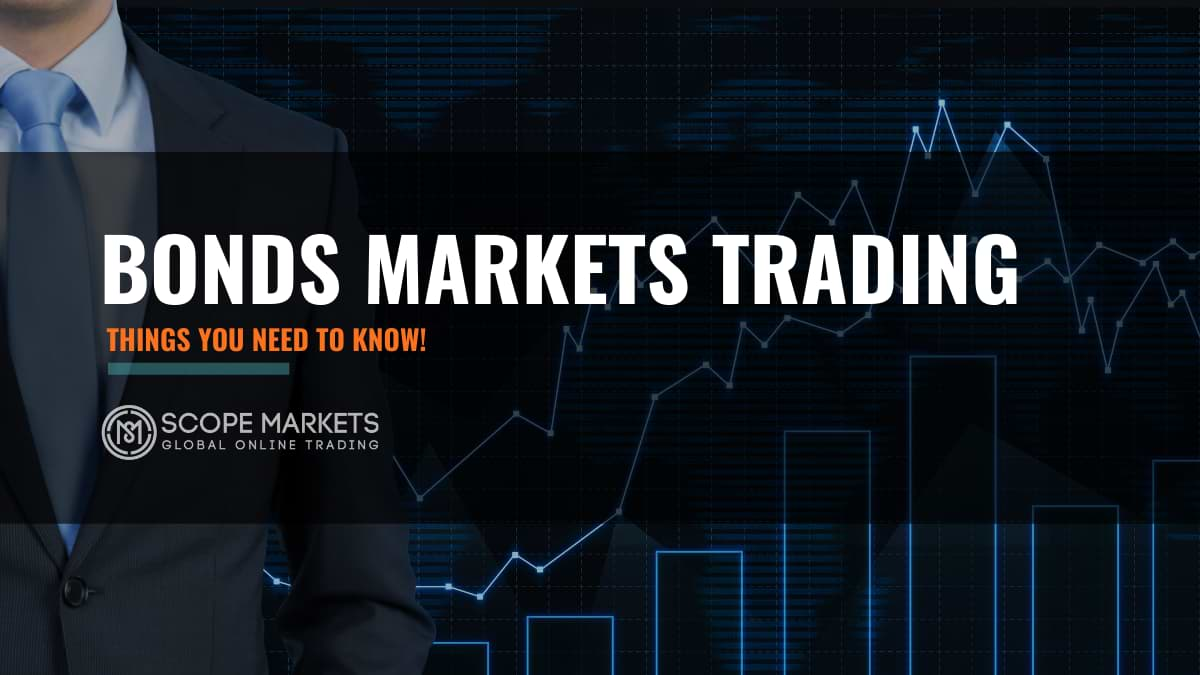Trading The Bonds Market – Important Things To Know

Table of Content
Knowledge of the bonds market and bonds trading is significant for proper investment. How is bonds trading done in the market seems tough to many individuals. But they are very significant to the economy and the general level of interest rates.
The bonds market is, without doubt, the biggest securities market all over the world. And, offering investors with endless investment alternatives. Various investors recognize the features of the market very well. But since the latest products have increased. Then, even a bond specialist gets a challenge to keep moving.
Once seen as a way of getting interest rates when upholding capital. Bonds have grown into a $100 trillion international marketplace. And, that can provide various possible advantages to investment securities, involving fair returns. Before working on the intricacies of this market, it’s essential to know fundamentals.
Things that make a bond a bond
A bond is a credit or loan that the bond buyer makes to the bond provider. Governments, businesses, and communities issue bonds when they requisite capital. A shareholder who purchases a government bond is granting the government cash. If a shareholder purchases a business bond, the investor is giving the business cash. Like a loan, a bond pays interest daily and returns the principal sum at a given time, called maturity.
For example, a company wishes to create a new production plant for $1 million. And, chooses to provide a bond offering to help compensate for the plant. The company might choose to sell 1,000 bonds to shareholders for $1,000 each. In this condition, the face value of every bond is $1,000. The company – now suggested as the bond provider. That identifies a yearly interest rate, called the coupon. And, a timeframe in which it would return the principal amount, or the $1 million.
How The Bond Works

To set the coupon, the issuer considers the current interest rate. Thus, to assure it’s competing with those on similar bonds and appealing to investors. The bond issuer may choose to exchange 5-year bonds with a yearly 5% coupon. After maturity, the company returns the $1,000 face worth to every bondholder. How much time it takes for a bond to reach maturity can play an essential role in the sum of risk. Also, the possible return a shareholder can foresee.
A $1 million bond moves when expectations change about economic growth and inflation. The large bond paid over 30 years. As various factors can have an adverse effect on the issuer’s ability to repay bondholders. That is more than a 30-year period related to a five-year period that the issuer should reimburse on the bond. In different words, an issuer would give a higher interest rate for the current bond. Thus, an investor would likely earn huge returns on long-term bonds. But, in change for that return, the investor acquires extra risk.
What Drives the Bond Trading Market?
The bonds market shifts when anticipations change in financial growth and buildup. Not like stocks, whose expected earnings are anybody’s opinion. Then, bonds generate fixed payments for a definite time. Investors choose how much to spend on a provided bond. And, that depends on how much they foresee expansion to erode the worth of those set payments.
The more their anticipations of inflation, the less they would return for bonds. The lesser they foresee inflation to be, the more they would pay.
In the bonds market, the lower prices compare to increased yields. And, more expensive prices compared to reduced yields. When prices drop, yields increase, and the other way around. The cause is simple: Yield evaluates the worth of a bond to a shareholder. And, that depends on how much the shareholder compensated for it. The lesser the price at which you own, the better the offer you will get. The more the price, the more inferior the deal.
A shareholder who gives a rate of 98 for a bond that gives profit or interest at the rate of 7% for ten years. Thus, he gets a bigger deal than a shareholder who gives 100 for a similar instrument. The shareholder who gives 98 gets an output of 7.25%. The shareholder who gives 100 obtains a profit of 7%.
What Identifies the Bond Price in the Open Market?
An investor can buy bonds and sell in a trivial market after they get issued. Whereas some bonds swap in public via exchanges. Most trade OTC within big broker-dealers working on their buyers’ or their own account.
A bond’s value and yield identify its worth in a trivial market. Definitely, a bond should have a rate at which an investor can buy and sell. Also, a bond’s earning is the true yearly return a stockholder can expect if the bond is set to maturity. Yield is thus dependent on the buying price of the bond along with the coupon.
It gives through its daily coupon interest repayments. When prevalent interest rates drop – government bonds’ rats become more valuable. As they can exchange in an increased interest rate environment. And, thus have more coupons.
Investors having earlier bonds can charge an incentive. So, to trade them in the subsidiary market. So, if interest rates grow, older bonds may turn out less important. As their coupons are almost flat, and earlier bonds thus trade at a percentage.
Significance of Bond Trading
Trading bonds takes place many times a day. And, is an essential part of international exchange markets. The bond market is far larger than the stock market. And, central banks carry a financial plan in the bonds markets. When buyers or sellers are trading their bonds, they manage the yields of diverse bonds. This in exchange fixes the credit price in the market.
Bonds trade everywhere that a seller and buyer can run into a deal. Unlike openly-traded stocks, there is no primary place or bourses for bond trading. The bond market is an OTC or over-the-counter market, in place of a regular exchange. Interchangeable bonds, any bond futures and bond options a trader can do on exchanges.
Bonds and Their Working Process
A trader can use bonds due to the large figures. And, that turn around taken by businesses and authorities. It would, thus, be difficult for a sole lender to grow the sum of capital required by these organizations.
In consequence, various loans from different stakeholders are stuck to single bond approval.
For instance, if the state of the UK has a plan worth £10 million. Then, it may choose to declare an expiation to trade bonds in aid of the project. The administration might attempt to trade 1,000 bonds under this deal with a status value of £10,000 for each.
Status value, in this condition, is the cost of the bond when it’s once issued. On the issuing of these bonds, the administration is liable to the bond’s interest rate. That depends on these factors as the current rates in the market.
The administration would also find out the maturation date of these bonds.
How Trading in the Bonds Market Done?
Bond trading is a process of attaining profits by using the change in the value of different kinds of bonds. For shareholders, bond trading is an essential attribute of their varied trading securities. And, also to cash and assets. Thus, bonds trading has 2 ways to get done;
1. Bourse or Exchange Trading
Exchange-traded bonds are generally state or company bonds. That a trader can trade in the regional currency. This is generally subject to parties within the first bonds market.
2. Over the Counter Trading
OTC trading is appropriate when a bond is an expansive marketplace. Investors may only trade in an OTC bonds market via a 3rd-party broker.
Different Bond Trading Strategies to Use
On the basis of the different roles that bonds perform in one’s expense. The investors own a range of bond trading strategies that they can use to their profit.These strategiescan be either inactive or active. And, that’s with current approaches considering the most important traded bond’s amount. Here are a few strategies employed in bond trading.
Buy or Hold Approach
This is a submissive strategy. That is best matched for investors considering portfolio change, dividends, or capital safety.
The approach indicates buying bonds and keeping them until they approach their maturity. The buy and hold strategy helps the reduction of costs. Because investors increase the production of earnings or profits.
The strategy of Bond Laddering
Bond laddering is also a submissive approach to bonds market trading. This strategy includes having over one bond with different maturities. Thereby, letting shareholders keep up the profit stream since they reduce costs.
In this strategy, shareholders use the interests of a grown short-term bond. Thus, to buy into a long-term bond.
The strategy of Bond Swapping
The bond swapping strategy includes the sale of a single bond to buy into another. Generally, investors use bond swapping. And, they use it to remove a lost bond in change for a bigger accomplishing bond. In the long-term, investors can get a huge investment amount. Because the target of this strategy is to change one’s financial situation.
Are Bonds the Best Investment to Make in 2020?
The COVID-19 outbreak has driven the stock market to an overhaul. Because traders with big portfolios foresee huge losses.
For many shareholders, the big query continues, is now the best time to get bonds?
As stocks stay falling with the international outburst. Then, the bond investment’s worth has increased much. Here’s why bonds investment in 2020 is the best strategy for traders.
The Ever-increasing Prices of the Bond
For decades, investment experts have put strictures on the bond market’s stability. Thus, indicating high possibilities of a drop in prices of the bond.
Yet, the worth of bonds has been on a steady growth even when their yields have tapped the most profound records. In some nations, bond yields have entered the adverse numbers. Thereby, driving investors to repay issuers for the event to spend on their bonds.
Besides, even with these reduced yields, the bonds’ price is evermore increasing. This is due to bonds, which are the most suitable option for dropping stocks.
A Drop in Yields Outcomes in an Increase in Prices
When the bonds’ market yield drops, their prices grow, creating bonds more useful. This is generally due to the current bonds come with more special coupons. And, that creates them more engaging when rates for the latest bonds drop.
The Development of Green Bonds
In the previous few years, the market of green bonds has grown very much. With the G20 heads holding the movement to increase Green Finance. And, many characteristics of Green Bonds have observed their path into the trades.
How do Novices Buy or Invest in Bonds?
The market of bonds can be difficult even to specialists. Previous to trading in bonds as a novice, you might want to consider several factors. Here’s what you would need to understand.
Ratings Investing in Bonds
Same to other kinds of investment, you wish to find out even if the bond you put money into would get returns. If the business, government, or company providing bonds cannot compensate for their bonds. Then, you would need to ignore this kind of investment.
If you want to find out the capacity of such organizations to refund your investment. Then, investors can use bond rankings given by different rating providers.
Investing in FTSE 100 Index
If you are aiming to buy corporate or business bonds in the UK, then the FTSE 100 Index would be of huge use to you. The FTSE 100 index is generally used for stock market-related issues. And, these are for checking the most unstable stocks of the FTSE 100 index.
Like a bonds market trader, the FTSE Index is important. Because it features the reliability of the best companies in the United Kingdom. A novice in bonds trading can use it to create a corporate bonds list. That is for potential investment and the prices of corporate bonds.
Activities of Bonds
Diverse investors buy bonds for differing causes. It is a must to fix the goal for which you aim to put money into bonds. Some of the activities of bonds involve;
- Security of capital.
- To get a planned earning in the coupon form.
- Change in the portfolio.
- Cushion next to financial decline.
- Capital obligation.
Exchanging Currencies While Trading Bonds
If you are handling bonds issued in exchange. That is separate from the investor’s national exchange. Then, having currency conversion knowledge is important. Shareholders can take the help of online currency calculators while trading the markets. When exchanging the currencies yourself, make sure you have a proper exchange rate.
Let’s suppose, the currency exchange rate among the Pound and Dollar is 1.23. So, to convert 5000 Pounds into Dollar, you would increase 5000 by 1.23, thus, coming out as $6150.
How to calculate underlying bond risk?
An opposite correlation between cost and yield is important to know the value of bonds. To get an insight into a bond’s price to interest rate changes, the bond market utilizes span or duration. It is a weighted mean of the current value of a bond’s cash flow. That involves a range of daily coupon payments supported by a much bigger payment. And, which is eventual when the bond grows and the maturity value is repaid.
Duration, such as the full growth of the bond is often shown in years. But, it is generally less than maturity. Duration will get influenced by the extent of the daily coupon returns and the bond’s maturity.
For a 0- coupon bond, maturity and span are the same since there are no daily coupon payments. Also, all cash flows take place at the maturity level. Due to this feature, 0-coupon bonds have a tendency to offer the greatest price movement. That is for a provided interest rate variation. Also, that can create o-coupon bonds. Which, in turn, appeals to investors who are anticipating a drop in rates.
Bonds and its role in a portfolio
As governments started issuing bonds more often in the previous 20th century. And, gave rise to the present bond market. Then, investors have bought bonds for various reasons. These are capital security, returns, diversity, and potential hedge upon a financial deflation. When the bond market turned out bigger and more distinct in the 1970s and 1980s. Then, bonds started undergoing larger and more common price variations. Also, various shareholders started trading bonds. So, getting one more benefit: cost, or capital, recognition.
Capital security
Not like equities, bonds must compensate the principal at a particular date. This creates bonds interesting to shareholders who don’t wish to risk their capital. And, to those who should fulfill a liability at a specific time in the prospect. Bonds have the added advantage of providing interest at a fixed rate. That is generally more than limited savings rates.
Returns
Many bonds offer the investor or shareholder with a set income. On a fixed plan, even if quarterly, two times a year, or yearly, the issuer sends the bondholder a credit amount. And, that an investor can pay or invest again in different bonds. Stocks can also offer earnings by dividend returns. But, dividends have a tendency to be more inadequate than bond coupon returns. Also, companies create dividend returns at their preference. Whereas bond providers or issuers are bound to generate coupon payments.
Capital recognition
The prices of bonds can increase for various reasons. And, these involve a fall in interest rates and an increase in the credit status of the bond issuer. If a bond is to keep at maturity, any price additions more than the length of the bond are not attained. In its place, the bond’s price generally turns back to par (100). Since it comes close to maturity and compensation of the principal amount.
Yet, by trading bonds later they have increased in cost. And, previous to maturity – shareholders can earn price recognition or capital appreciation. Seizing capital recognition on bonds improves their whole return. That, in turn, is the sequence of gains and capital recognition.
Diversity
Adding bonds in an endowment portfolio can assist in diversifying the portfolio. Various investors change amongst a broad range of assets. That is from assets and bonds to commodities and optional investments. Such is to decrease the risk of small, or even contrary, yields on their portfolios.
Possible hedge upon a financial decline
Bonds may help in securing shareholders who face a financial delay. The bond price relies on how much shareholders ‘ worth the revenue the bond provides. Many bonds offer a fixed commission that doesn’t vary.
When a product or service cost is rising, then a financial condition known as expansion. A bond’s set income turns out less attractive as that income owns fewer goods or services. Inflation or expansion generally clashes with quicker financial growth. That grows demand for products or services. But, slower financial growth generally directs to lower expansion. And, it creates bond returns more engaging. Financial retardation is also critical for collective profits and stock income. Thus, adding to the fascination of bond revenue as a reference of return.
If the slowdown becomes so critical that consumers stop buying things. And, costs in the market started falling. Then, this financial condition is deflation. In which, the bond income becomes even more engaging. It’s because bond investors can own more products and services with the same bond assets. As the need for bonds rises, so do bond costs and bond investors’ returns.
Conclusion
Bonds market trading is a weaker form than stock trading, but it’s more significant. Bond traders and investors change their portfolios in view of varying market situations. Thus, to generate a profit or increase the income on their portfolios. The impact of this bond market movement is the current level of interest rates, in a specific economy. Which, in turn, impacts all kinds of credit as well as lending.
References:
Finpipe – Trading bonds
Europe pimco – Everything you need to know about bonds
Thestreet – Frequently asked questions about the bond market
Disclaimer: This material is a marketing communication and shall not in any case be construed as an investment advice, investment recommendation or presentation of an investment strategy. The marketing communication is prepared without taking into consideration the individual investors personal circumstances, investment experience or current financial situation. Any information contained therein in regardsto past performance or future forecasts does not constitute a reliable indicator of future performance, as circumstances may change over time. Scope Markets shall not accept any responsibility for any losses of investors due to the use and the content of the abovementioned information. Please note that forex trading and trading in other leveraged products involves a significant level of risk and is not suitable for all investors.







